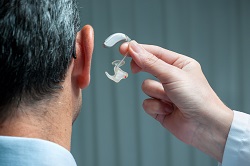A new ‘look’ at listening effort measurement
Hearing impairment is one of the most common disabilities that causes sufferers to withdraw from social interactions. The result is a negative effect on work performance, distress, increased sick leave, early retirement and a greater need for recovery due to increased listening effort and a lack of energy. A greater understanding is required of what listening effort compromises to explain the relationship between fatigue and lack of energy in real life. The EU-funded LISTEN project investigated which current and new hearing aid technologies can successfully reduce the level of effort required during speech perception. ‘Two early stage researchers (ESRs) were trained and seconded to one of the largest hearing aid manufacturers in Europe, who provided them with specialised training,’ says project coordinator Professor Sophia Kramer. ‘New strategies and practices required for further innovation in hearing aid technology and measuring outcomes were also developed.’ ESRs studied the use of pupillometry, which measures the eye’s pupil size and reactivity by infrared photography. ‘The change in pupil diameter caused by a stimulus or task provides an indication of how demanding or effortful the task is, as long as the illumination level is controlled. In general, the more demanding the task, the larger the pupil dilation response,’ explains Prof. Kramer. Greater sensitivity in speech recognition The researchers developed a new approach for evaluating the extent to which hearing solutions such as hearing aids reduce effort. Until now, pure-tone audiometry sometimes combined with traditional speech recognition measures have been used in hearing aid development and research. According to Prof. Kramer: ‘Because traditional speech recognition measures lack the sensitivity to be applied under these easier, quieter conditions, speech recognition tests cannot be adequately used as an outcome for hearing aid benefit research.’ Further development of pupillometry as an alternative form of measurement revealed how listening effort – with and without the use of hearing aids – is modulated across the entire range of day-to-day listening, from impossible to extremely easy speech understanding. Rather than utilising conditions representing difficult and noisy listening situations in daily life, LISTEN provided knowledge and evidence for more realistic (that is easier and quieter) listening situations. ‘A novel finding is that while hearing aids increase speech understanding in difficult listening situations, they also significantly reduce listening effort under easier listening conditions,’ states Prof. Kramer. A major contribution to hearing science The underlying mechanisms of the pupil dilation response were further unravelled in studies measuring the pupil light reflex. These studies revealed that an individual’s level of fatigue influences the level of effort one can exert. ‘This is a breakthrough in our understanding of the mechanisms behind listening effort and the pupil dilation response,’ comments Prof. Kramer. ‘Overall, both in the academic and industrial setting, LISTEN’s impact has been huge and this new knowledge and the new procedures concerning pupillometry have been adopted by many labs around the world.’ LISTEN contributed to a worldwide process associated with a paradigm shift in the field of hearing science. This shift is related to the change in diagnostic methods used to evaluate the benefits of hearing aids. In addition, the ESRs gained an understanding of legal issues, commercial awareness, R&D, and the organisation and function of a large industrial concern. They also witnessed the filing of patents and received training on how to valorise their scientific results. Prof. Kramer concludes: ‘The project provided the ESRs with a unique environment, enabling them to become experts in research that supports healthy ageing in our communication-based societies.’



